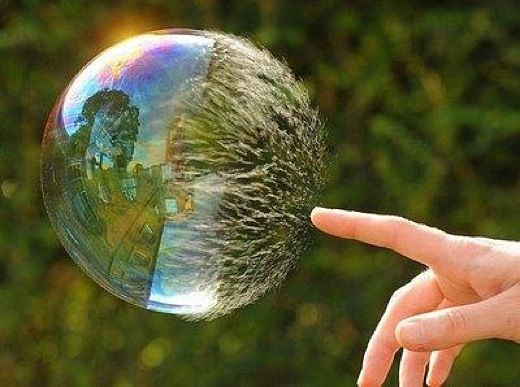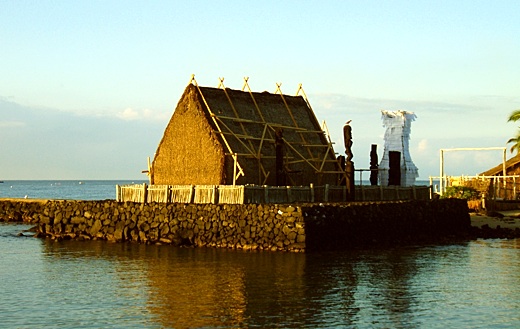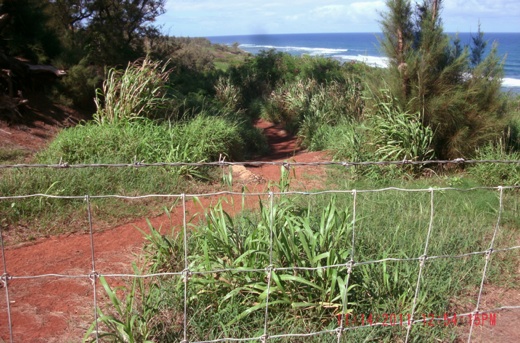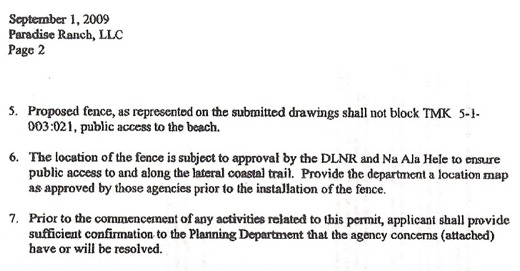SUBHEAD: It’s quite possible that the bubble is large enough to cause a major financial panic when it soon bursts.
By John Michael Greer on 27 February 2013 for Archdruid Report -
(http://thearchdruidreport.blogspot.com/2013/02/the-end-of-shale-bubble.html)

Image above: A soup bubble needs only a gentle touch to burst. From (http://www.solarfeeds.com/shale-gas-the-next-bubble-to-burst/).
Those who were paying attention to all the hoopla may have noticed that the vaporous claims being retailed by the mainstream media around the fracking boom resembled nothing so much as the equally insubstantial arguments most of the same media were serving up around the housing boom in the years immediately before the 2008 crash. The similarity isn’t accidental, either. The same thing happened in both cases: Wall Street got into the act.
A recent report from financial analyst Deborah Rogers, Shale and Wall Street (you can download a copy in PDF format here), offers a helpful glimpse into the three-ring speculative circus that sprang up around shale oil and shale gas during the last three years or so.
.
By John Michael Greer on 27 February 2013 for Archdruid Report -
(http://thearchdruidreport.blogspot.com/2013/02/the-end-of-shale-bubble.html)

Image above: A soup bubble needs only a gentle touch to burst. From (http://www.solarfeeds.com/shale-gas-the-next-bubble-to-burst/).
It’s been a little more than a year since I launched the present series of posts on the end of America’s global empire and the future of democracy in the wake of this nation’s imperial age. Over the next few posts I plan on wrapping that theme up and moving on. However traumatic the decline and fall of the American empire turns out to be, after all, it’s just one part of the broader trajectory that this blog seeks to explore, and other parts of that trajectory deserve discussion as well.
I’d planned to have this week’s post take last week’s discussion of voluntary associations further, and talk about some of the other roles that can be filled, in a time of economic contraction and social disarray, by groups of people using the toolkit of democratic process and traditional ways of managing group activities and assets. Still, that topic is going to have to wait another week, because one of the other dimensions of the broader trajectory just mentioned is moving rapidly toward crisis.
It’s hard to imagine that anybody in today’s America has escaped the flurry of enthusiastic media coverage of the fracking phenomenon. Still, that coverage has included so much misinformation that it’s probably a good idea to recap the basics here.
I’d planned to have this week’s post take last week’s discussion of voluntary associations further, and talk about some of the other roles that can be filled, in a time of economic contraction and social disarray, by groups of people using the toolkit of democratic process and traditional ways of managing group activities and assets. Still, that topic is going to have to wait another week, because one of the other dimensions of the broader trajectory just mentioned is moving rapidly toward crisis.
It’s hard to imagine that anybody in today’s America has escaped the flurry of enthusiastic media coverage of the fracking phenomenon. Still, that coverage has included so much misinformation that it’s probably a good idea to recap the basics here.
Hydrofracturing—“fracking” in oil industry slang—is an old trick that has been used for decades to get oil and natural gas out of rock that isn’t porous enough for conventional methods to get at them. As oil and gas extraction techniques go, it’s fairly money-, energy- and resource-intensive, and so it didn’t see a great deal of use until fairly recently.
Then the price of oil climbed to the vicinity of $100 a barrel and stayed there. Soaring oil prices drove a tectonic shift in the US petroleum industry, making it economically feasible to drill for oil in deposits that weren’t worth the effort when prices were lower. One of those deposits was the Bakken shale, a sprawling formation of underground rock in the northern Great Plains, which was discovered back in the 1970s and sat neglected ever since due to low oil prices.
Then the price of oil climbed to the vicinity of $100 a barrel and stayed there. Soaring oil prices drove a tectonic shift in the US petroleum industry, making it economically feasible to drill for oil in deposits that weren’t worth the effort when prices were lower. One of those deposits was the Bakken shale, a sprawling formation of underground rock in the northern Great Plains, which was discovered back in the 1970s and sat neglected ever since due to low oil prices.
To get any significant amount of oil out of the Bakken, you have to use fracking technology, since the shale isn’t porous enough to let go of its oil any other way. Once the rising price of crude oil made the Bakken a paying proposition, drilling crews headed that way and got to work, launching a lively boom.
Another thoroughly explored rock formation further east, the Marcellus shale, attracted attention from the drilling rigs for a different reason, or rather a different pair of reasons. The Marcellus contains no oil to speak of, but some parts of it have gas that is high in natural gas liquids—“wet gas” is the industry term for this—and since those liquids can replace petroleum in some applications, they can be sold at a much higher price than natural gas.
Another thoroughly explored rock formation further east, the Marcellus shale, attracted attention from the drilling rigs for a different reason, or rather a different pair of reasons. The Marcellus contains no oil to speak of, but some parts of it have gas that is high in natural gas liquids—“wet gas” is the industry term for this—and since those liquids can replace petroleum in some applications, they can be sold at a much higher price than natural gas.
Meanwhile, companies across the natural gas industry looked at the ongoing depletion of US coal reserves, and the likelihood of government mandates favoring natural gas over coal for power generation, and decided that these added up to a rosy future for natural gas prices. Several natural gas production firms thus started snapping up leases in the Marcellus country of Pennsylvania and neighboring states, and a second boom got under way.
As drilling in the Bakken and Marcellus shales took off, several other shale deposits, some containing oil and natural gas, others just natural gas, came in for the same sort of treatment. The result was a modest temporary increase in US petroleum production, and a more substantial but equally temporary increase in US natural gas production. It could never be anything more than temporary, for reasons hardwired into the way fracking technology works.
If you’ve ever shaken a can of soda pop good and hard and then opened it, you know something about fracking that countless column inches of media cheerleading on the subject have sedulously avoided.
As drilling in the Bakken and Marcellus shales took off, several other shale deposits, some containing oil and natural gas, others just natural gas, came in for the same sort of treatment. The result was a modest temporary increase in US petroleum production, and a more substantial but equally temporary increase in US natural gas production. It could never be anything more than temporary, for reasons hardwired into the way fracking technology works.
If you’ve ever shaken a can of soda pop good and hard and then opened it, you know something about fracking that countless column inches of media cheerleading on the subject have sedulously avoided.
The technique is different, to be sure, but the effect of hydrofracturing on oil and gas trapped in shale is not unlike the effect of a hard shake on the carbon dioxide dissolved in soda pop: in both cases, you get a sudden rush toward the outlet, which releases most of what you’re going to get. Oil and gas production from fracked wells thus starts out high but suffers ferocious decline rates—up to 90% in the first year alone.
Where a conventional, unfracked well can produce enough oil or gas to turn a profit for decades if it’s well managed, fracked wells in tight shales like the Bakken and Marcellus quite often stop becoming a significant source of oil or gas within a few years of drilling.
The obvious response to this problem is to drill more wells, and this accordingly happened. That isn’t a panacea, however. Oil and gas exploration is a highly sophisticated science, and oil and gas drilling companies can normally figure out the best sites for wells long before the drill bit hits the ground. Since they are in business to make money, they normally drill the best sites first.
The obvious response to this problem is to drill more wells, and this accordingly happened. That isn’t a panacea, however. Oil and gas exploration is a highly sophisticated science, and oil and gas drilling companies can normally figure out the best sites for wells long before the drill bit hits the ground. Since they are in business to make money, they normally drill the best sites first.
When that sensible habit intersects with the rapid production decline rates found in fracked wells, the result is a brutal form of economic arithmetic: as the best sites are drilled and the largest reserves drained, drilling companies have to drill more and more wells to keep the same amount of oil or gas flowing. Costs go up without increasing production, and unless prices rise, profits get hammered and companies start to go broke.
They start to go broke even more quickly if the price of the resource they’re extracting goes down as the costs of maintaining production go up. In the case of natural gas, that’s exactly what happened. Each natural gas production company drew up its projections of future prices on the assumption that ordinary trends in production would continue.
They start to go broke even more quickly if the price of the resource they’re extracting goes down as the costs of maintaining production go up. In the case of natural gas, that’s exactly what happened. Each natural gas production company drew up its projections of future prices on the assumption that ordinary trends in production would continue.
As company after company piled into shale gas, though, production soared, and the harsh economic downturn that followed the 2008 housing market crash kept plummeting natural gas prices from spurring increased use of the resource; so many people were so broke that even cheap natural gas was too expensive for any unnecessary use.
Up to that point, the fracking story followed a trajectory painfully familiar to anyone who knows their way around the economics of alternative energy. From the building of the first solar steam engines before the turn of the last century, through the boom-and-bust cycle of alternative energy sources in the late 1970s, right up to the ethanol plants that were launched with so much fanfare a decade ago and sold for scrap much more quietly a few years later, the pattern’s the same, a repeated rhythm of great expectations followed by shattered dreams. .
Here’s how it works. A media panic over the availability of some energy resource or other sparks frantic efforts to come up with a response that won’t require anybody to change their lifestyles or, heaven help us, conserve.
Up to that point, the fracking story followed a trajectory painfully familiar to anyone who knows their way around the economics of alternative energy. From the building of the first solar steam engines before the turn of the last century, through the boom-and-bust cycle of alternative energy sources in the late 1970s, right up to the ethanol plants that were launched with so much fanfare a decade ago and sold for scrap much more quietly a few years later, the pattern’s the same, a repeated rhythm of great expectations followed by shattered dreams. .
Here’s how it works. A media panic over the availability of some energy resource or other sparks frantic efforts to come up with a response that won’t require anybody to change their lifestyles or, heaven help us, conserve.
Out of the flurry of available resources and technologies, one or two seize the attention of the media and, shortly thereafter, the imagination of the general public. Money pours into whatever the chosen solution happens to be, as investors convince themselves that there’s plenty of profit to be made backing a supposedly sure thing, and nobody takes the time to ask hard questions.
In particular, investors tend to lose track of the fact that something can be technically feasible without being economically viable, and rosy estimates of projected cash flow and return on investment take the place of meaningful analysis.
Then come the first financial troubles, brushed aside by cheerleading “analysts” as teething troubles or the results of irrelevant factors certain to pass off in short order. The next round of bad news follows promptly, and then the one after that; the first investors begin to pull out; sooner or later, one of the hot companies that has become an icon in the new industry goes suddenly and messily bankrupt, and the rush for the exits begins.
Then come the first financial troubles, brushed aside by cheerleading “analysts” as teething troubles or the results of irrelevant factors certain to pass off in short order. The next round of bad news follows promptly, and then the one after that; the first investors begin to pull out; sooner or later, one of the hot companies that has become an icon in the new industry goes suddenly and messily bankrupt, and the rush for the exits begins.
Barring government subsidies big enough to keep some shrunken form of the new industry stumbling along thereafter, that’s usually the end of the road for the former solution du jour, and decades can pass before investors are willing to put their money into the same resource or technology again.
That’s the way that the fracking story started, too. By the time it was well under way, though, a jarring new note had sounded: the most prestigious of the US mass media suddenly started parroting the most sanguine daydreams of the fracking industry.
That’s the way that the fracking story started, too. By the time it was well under way, though, a jarring new note had sounded: the most prestigious of the US mass media suddenly started parroting the most sanguine daydreams of the fracking industry.
They insisted at the top of their lungs that the relatively modest increases in oil and gas production from fracked shales marked a revolutionary new era, in which the United States would inevitably regain the energy independence it last had in the 1950s, and prosperity would return for all—or at least for all who jumped aboard the new bandwagon as soon as possible. Happy days, we were told, were here again.
What made this barrage of propaganda all the more fascinating was the immense gaps that separated it from the realities on and under the ground in Pennsylvania and North Dakota. The drastic depletion rates from fracked wells rarely got a mention, and the estimates of how much oil and gas were to be found in the various shale deposits zoomed upwards with wild abandon.
What made this barrage of propaganda all the more fascinating was the immense gaps that separated it from the realities on and under the ground in Pennsylvania and North Dakota. The drastic depletion rates from fracked wells rarely got a mention, and the estimates of how much oil and gas were to be found in the various shale deposits zoomed upwards with wild abandon.
Nor did the frenzy stop there; blatant falsehoods were served up repeatedly by people who had every reason to know that they were false—I’m thinking here of the supposedly energy-literate pundits who insisted, repeatedly and loudly, that the Green River shale in the southwest was just like the Bakken and Marcellus shales, and would yield abundant oil and gas once it was fracked.
The Green River shale, for those who haven’t been keeping score, contains no oil or gas at all; instead, it contains kerogen, a waxy hydrocarbon goo that would have turned into oil or gas if it had stayed deep underground for a few million years longer, and kerogen can’t be extracted by fracking—or, for that matter, by any other economically viable method.
Those who were paying attention to all the hoopla may have noticed that the vaporous claims being retailed by the mainstream media around the fracking boom resembled nothing so much as the equally insubstantial arguments most of the same media were serving up around the housing boom in the years immediately before the 2008 crash. The similarity isn’t accidental, either. The same thing happened in both cases: Wall Street got into the act.
A recent report from financial analyst Deborah Rogers, Shale and Wall Street (you can download a copy in PDF format here), offers a helpful glimpse into the three-ring speculative circus that sprang up around shale oil and shale gas during the last three years or so.
Those of my readers who suffer from the delusion that Wall Street might have learned something from the disastrous end of the housing bubble are in for a disappointment: the same antics, executed with the same blissful disregard for basic honesty and probity, got trotted out again, with results that will be coming down hard on what’s left of the US economy in the months immediately ahead of us.
If you remember the housing bubble, you know what happened. Leases on undrilled shale fields were bundled and flipped on the basis of grotesquely inflated claims of their income potential; newly minted investment vehicles of more than Byzantine complexity.
If you remember the housing bubble, you know what happened. Leases on undrilled shale fields were bundled and flipped on the basis of grotesquely inflated claims of their income potential; newly minted investment vehicles of more than Byzantine complexity.
VPPs, "volumetric production payments," are an example you’ll be hearing about quite a bit in a few months, once the court cases begin—were pushed on poorly informed investors and promptly began to crash and burn; as the price of natural gas dropped and fracking operations became more and more unprofitable, "pump and dump" operations talked up the prospects of next to worthless properties, which could then be unloaded on chumps before the bottom fell out.
It’s an old story, if a tawdry one, and all the evidence suggests that it’s likely to finish running its usual course in the months immediately ahead.
There are at least two points worth making as that happens. The first is that we can expect more of the same in the years immediately ahead. Wall Street culture—not to mention the entire suite of economic expectations that guides the behavior of governments, businesses, and most individuals in today’s America—assumes that the close-to-zero return on investment that’s become standard in the last few years is a temporary anomaly, and that a good investment ought to bring in what used to be considered a good annual return: 4%, 6%, 8%, or more.
There are at least two points worth making as that happens. The first is that we can expect more of the same in the years immediately ahead. Wall Street culture—not to mention the entire suite of economic expectations that guides the behavior of governments, businesses, and most individuals in today’s America—assumes that the close-to-zero return on investment that’s become standard in the last few years is a temporary anomaly, and that a good investment ought to bring in what used to be considered a good annual return: 4%, 6%, 8%, or more.
What only a few thinkers on the fringes have grasped is that such returns are only normal in a growing economy, and we no longer have a growing economy.
Sustained economic growth, of the kind that went on from the beginning of the industrial revolution around 1700 to the peak of conventional oil production around 2005, is a rare anomaly in human history. It became a dominant historical force over the last three centuries because cheap abundant energy from fossil fuels could be brought into the economy at an ever-increasing rate, and it stopped because geological limits to fossil fuel extraction put further increases in energy consumption permanently out of reach.
Sustained economic growth, of the kind that went on from the beginning of the industrial revolution around 1700 to the peak of conventional oil production around 2005, is a rare anomaly in human history. It became a dominant historical force over the last three centuries because cheap abundant energy from fossil fuels could be brought into the economy at an ever-increasing rate, and it stopped because geological limits to fossil fuel extraction put further increases in energy consumption permanently out of reach.
Now that fossil fuels are neither cheap nor abundant, and the quest for new energy sources vast and concentrated enough to replace them has repeatedly drawn a blank, we face several centuries of sustained economic contraction—which means that what until recently counted as the groundrules of economics have just been turned on their head.
You will not find many people on Wall Street capable of grasping this. The burden of an outdated but emotionally compelling economic orthodoxy, to say nothing of a corporate and class culture that accords economic growth the sort of unquestioned aura of goodness other cultures assign to their gods, make the end of growth and the coming of permanent economic decline unthinkable to the financial industry, or for that matter to the millions of people in the industrial world who rely on investments to pay their bills.
You will not find many people on Wall Street capable of grasping this. The burden of an outdated but emotionally compelling economic orthodoxy, to say nothing of a corporate and class culture that accords economic growth the sort of unquestioned aura of goodness other cultures assign to their gods, make the end of growth and the coming of permanent economic decline unthinkable to the financial industry, or for that matter to the millions of people in the industrial world who rely on investments to pay their bills.
There’s a strong temptation to assume that those 8% per annum returns must still be out there, and when something shows up that appears to embody that hope, plenty of people are willing to rush into it and leave the hard questions for later. Equally, of course, the gap thus opened between expectations and reality quickly becomes a happy hunting ground for scoundrels of every stripe.
Vigorous enforcement of the securities laws might be able to stop the resulting spiral into a permanent bubble-and-bust economy. For all the partisan bickering in Washington DC, though, a firm bipartisan consensus since the days of George W. Bush has placed even Wall Street’s most monumental acts of piracy above the reach of the law. The Bush and Obama administrations both went out of their way to turn a blind eye toward the housing bubble’s spectacular frauds, and there’s no reason to think Obama’s appointees in the Justice Department will get around to doing their jobs this time either.
Vigorous enforcement of the securities laws might be able to stop the resulting spiral into a permanent bubble-and-bust economy. For all the partisan bickering in Washington DC, though, a firm bipartisan consensus since the days of George W. Bush has placed even Wall Street’s most monumental acts of piracy above the reach of the law. The Bush and Obama administrations both went out of their way to turn a blind eye toward the housing bubble’s spectacular frauds, and there’s no reason to think Obama’s appointees in the Justice Department will get around to doing their jobs this time either.
Once the imminent shale bust comes and goes, in other words, it’s a safe bet that there will be more bubbles, each one propping up the otherwise dismal prospects of the financial industry for a little while, and then delivering another body blow to the economies of America and the world as it bursts.
This isn’t merely a problem for those who have investments, or those whose jobs depend in one way or another on the services the financial industry provides when it’s not too busy committing securities fraud to get around to it. The coming of a permanent bubble-and-bust economy puts a full stop at the end of any remaining prospect for even the most tentative national transition away from our current state of dependence on fossil fuels.
This isn’t merely a problem for those who have investments, or those whose jobs depend in one way or another on the services the financial industry provides when it’s not too busy committing securities fraud to get around to it. The coming of a permanent bubble-and-bust economy puts a full stop at the end of any remaining prospect for even the most tentative national transition away from our current state of dependence on fossil fuels.
Pick a project, any project, from so sensible a step as rebuilding the nation’s long-neglected railroads all the way to such pie-in-the-sky vaporware as solar power satellites, and it’s going to take plenty of investment capital. If it’s to be done on any scale, furthermore, we’re talking about a period of decades in which more capital every year will have to flow into the project.
The transition to a bubble-and-bust economy makes that impossible. Bubbles last for an average of three years or so, so even if the bubble-blowers on Wall Street happen by accident on some project that might actually help, it will hardly have time to get started before the bubble turns to bust, the people who invested in the project get burned, and the whole thing tumbles down into disillusionment and bankruptcy.
The transition to a bubble-and-bust economy makes that impossible. Bubbles last for an average of three years or so, so even if the bubble-blowers on Wall Street happen by accident on some project that might actually help, it will hardly have time to get started before the bubble turns to bust, the people who invested in the project get burned, and the whole thing tumbles down into disillusionment and bankruptcy.
If past experience is anything to go by, furthermore, most of the money thus raised will be diverted from useful purposes into the absurd bonuses and salaries bankers and brokers think society owes them for their services.
Over the longer run, a repeated drumbeat of failed investments and unpunished fraud puts the entire system of investment itself at risk. The trust that leads people to invest their assets, rather than hiding them in a hole in the ground, is a commons; like any commons, it can be destroyed by abuse; and since the federal government has abandoned its statutory duty to protect that commons by enforcing laws against securities fraud, a classic tragedy of the commons is the most likely outcome, wrecking the system by which our society directs surplus wealth toward productive uses and putting any collective response to the end of the fossil fuel age permanently out of reach.
All these are crucial issues. Still, there’s a second point of more immediate importance. I don’t think anybody knows exactly how big the shale bubble has become, but it’s been one of Wall Street’s few really large profit centers over the last three years. It’s quite possible that the bubble is large enough to cause a major financial panic when it bursts, and send the United States and the world down into yet another sharp economic downturn.
Over the longer run, a repeated drumbeat of failed investments and unpunished fraud puts the entire system of investment itself at risk. The trust that leads people to invest their assets, rather than hiding them in a hole in the ground, is a commons; like any commons, it can be destroyed by abuse; and since the federal government has abandoned its statutory duty to protect that commons by enforcing laws against securities fraud, a classic tragedy of the commons is the most likely outcome, wrecking the system by which our society directs surplus wealth toward productive uses and putting any collective response to the end of the fossil fuel age permanently out of reach.
All these are crucial issues. Still, there’s a second point of more immediate importance. I don’t think anybody knows exactly how big the shale bubble has become, but it’s been one of Wall Street’s few really large profit centers over the last three years. It’s quite possible that the bubble is large enough to cause a major financial panic when it bursts, and send the United States and the world down into yet another sharp economic downturn.
As Yogi Berra famously pointed out, it’s tough to make predictions, especially about the future; still, I don’t think it’s out of place to suggest that sensible preparations for hard times might be wise just now, and if any of my readers happen to have anything invested in the shale or financial industries, I’d encourage them to consider other options in the fairly near term.
.








